Gangster Women
Kate Warner / University of Queensland
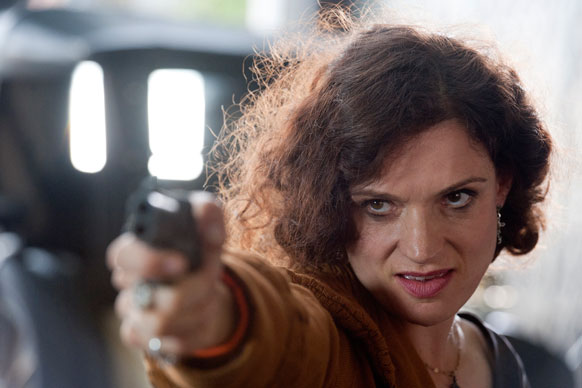
Danielle Cormack portrays Kate Leigh in Underbelly: Razor
The gangster genre1 is a longstanding and popular one in both film and television. The genre almost always focuses on male characters and much academic writing on the topic considers the gangster genre to be primarily about masculinity. This means that the spate of female gangsters, in central roles in recent television shows, is worthy of discussion. Female characters could undertake a number of roles in the business of crime; however, I am going to limit my analysis to women who are in charge of their own criminal organizations: Mags Bennett from Justified, Nancy Botwin from Weeds, and Tilly Devine and Kate Leigh from Underbelly: Razor.2
The definition of the gangster film, as established in the 1950s by Robert Warshow, includes a rise-and-fall narrative; a tragic, urban anti-hero; a critique of modern life and consumerism; and the use of violence to obtain the “American Dream” (Grieveson, Sonnet et al. 2005).3 While there are revisions and disputes of this classic definition I am going to use it as a sounding board in this discussion.
Gangsters are primarily motivated by achieving money and power. They may also be motivated by cruelty, violence, or revenge but the fact that they are attempting to make money through organized crime is a central part of the definition of the type. Furthermore, it is often the violent aspects of the gangster’s character that bring his or her downfall. The women in my examples are all motivated by money and power, and they all use violence; however, only one of them suffers an ultimate downfall.
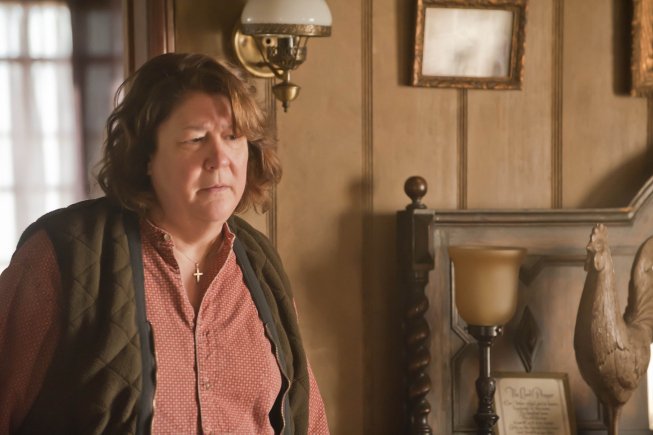
Margo Martindale as Mags Bennett, an antagonist on Justified
Justified is an FX series (2010 – present). Its central character is Raylan Givens, a U.S. Marshal transferred to his home state of Kentucky in disgrace. The show is usually episodic but has overarching seasonal villains. As a result of the episodic structure and central lawman character, Justified has the most traditional narrative form of the shows under examination. In the second season the villain is Mags Bennett, a middle-aged, raw-boned, and apparently uneducated woman—a stereotypical hillbilly, who still makes and drinks moonshine. Mags runs a criminal enterprise in rural Kentucky, and is assisted by her three sons. At the beginning of the season she is a powerful member of her community, one who performs, or at least attempts to perform, the role of vigilante justice. The first murder that she commits is of a man who went outside the community and informed the authorities that his daughter is being threatened by a child molester. Mags rules her family and her community with a rod of iron; when one of her sons disobeys her she breaks his hand with a hammer. Her highest point and moment of triumph is when, through treachery and betrayal of her own community, she manages to secure a legal fortune by selling out to a mining company.
Historically there have been few famous female gangsters However, one that stands out is Ma Barker. According to the legend Ma Barker was an intelligent woman, elderly and often represented as sexless, who ran a gang made up of her stupid and violent sons. She is usually portrayed as an unnatural mother (Strunk 2005).4 A number of films have been made about Ma Barker, most recently Bloody Mama (1970), and she has become a noticeable archetype in popular culture. (For example, Ma Fratelli in The Goonies (1985) is a loose caricature). Mags Bennett clearly has some aspects of this archetype and is therefore part of an already existing tradition of representation of the female gangster. She is also the villain and not the protagonist of the story. Yet she is powerful, she is intelligent, and like the classic gangster she goes out on her own terms, killing herself with poison, her own chosen weapon.
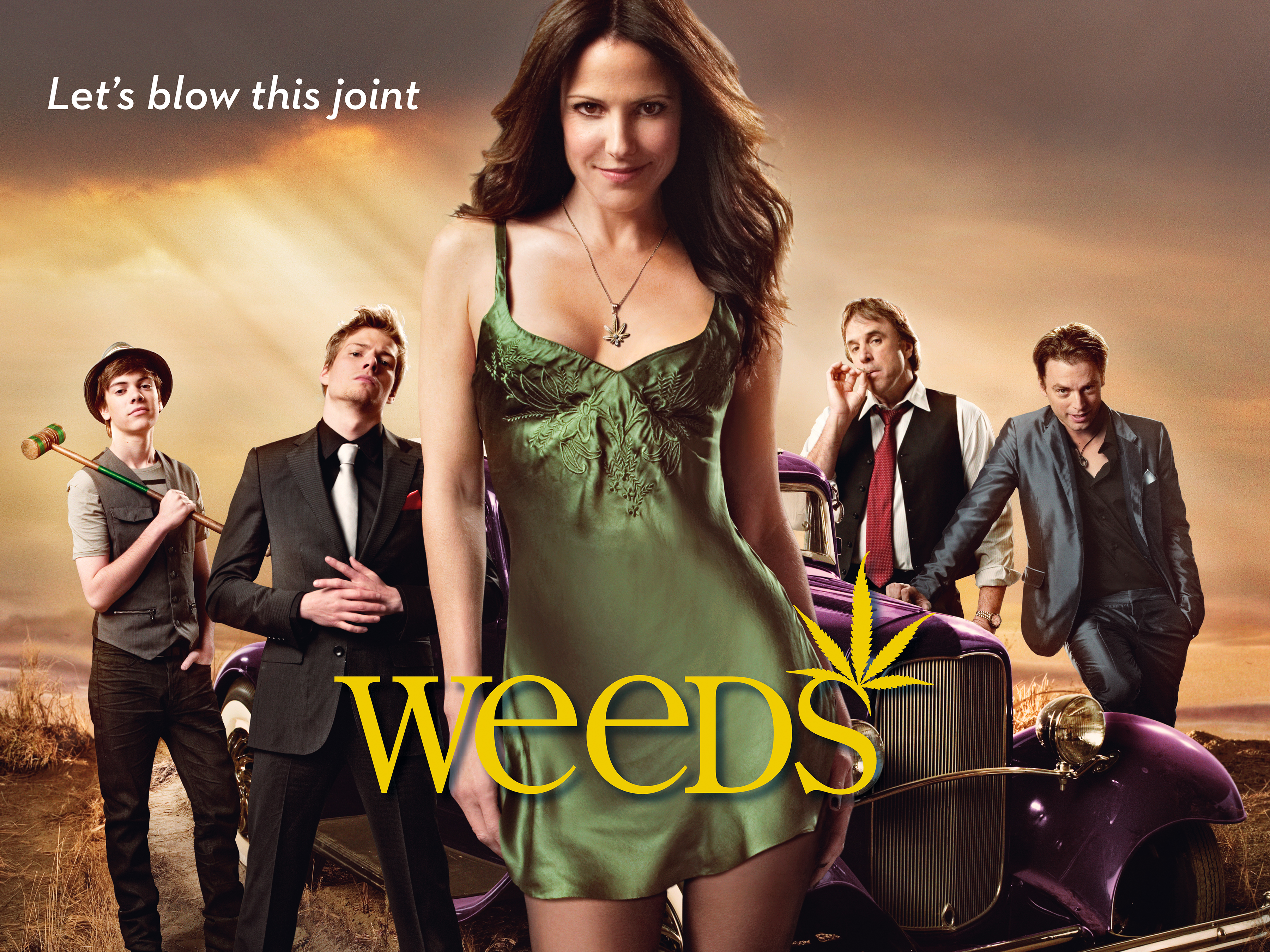
Mary-Louise Parker plays Nancy Botwin, a suburban mom turned pot dealer
Weeds was a Showtime half-hour comedy drama that ran for eight seasons (2005-2012). The show’s premise was that Nancy Botwin started to sell marijuana when left impoverished after the death of her husband. However, over the course of the show she moves from selling to growing to large-scale distribution, becoming more ambitious and greedy in the process. Nancy is the central protagonist of the program and her tale is a repeated rise-and-fall narrative, but in contrast to a standard gangster narrative, Nancy’s story ends on a rise.
Nancy is a flawed character, in many ways an anti-hero. The earlier seasons of the show are more lighthearted and the comedy tends to obscure the fact that Nancy is a criminal businesswoman. However, as the show develops it becomes clear that it is Nancy’s flaws that lead to her loved ones getting hurt and also to her business setbacks. It is worth noting that whilst not unheard of, female anti-heroes are unusual, even in comedy, meaning that Nancy has significant rarity value.
Nancy also shows some relationship to the classic Ma Barker character. Her two sons start out innocent but eventually become criminals and involved in their mother’s business. Yet unlike the traditional Ma Barker, Nancy is attractive and sexually active, and uses her sexuality to achieve power. Nancy is somewhat sexually promiscuous but it is on her own terms. While her behavior sometimes incurs negative consequences, it does not remove her from being the protagonist of the narrative. Weeds is Nancy’s story and therefore she remains center stage, even when using her sexuality to make ill-advised alliances with Mexican drug lords.
Weeds is sometimes contradictory. Picture 3 above is an example of this. Nancy is pictured in a state of undress, bold and sexy. Her sons and associates stand behind her dressed in classic 1920s gangster outfits. Yet Nancy is the center of the show’s narrative—all action flows from her and she is the one in charge of the business.
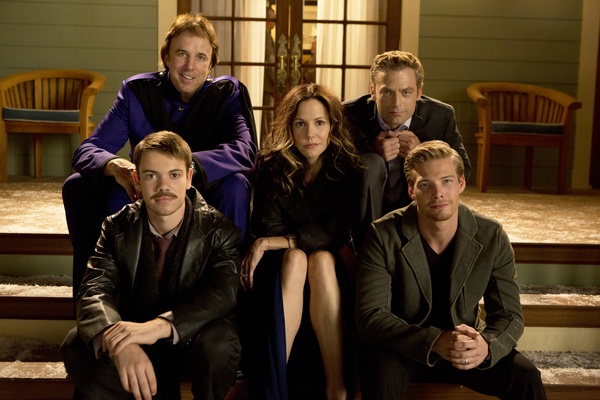
The cast of Weeds
Nancy has similarities to a classic gangster: she is greedy and ambitious, she acts in an organized and criminal way, she benefits from and organizes acts of violence, she acts selfishly—assuming that her family will remain loyal to her no matter what. But at the end of the series she is not punished for her sins, even her family at least partially forgives her.
The final example most closely fits the mold of the classic gangster story. Underbelly: Razor was an Australian production for broadcast television in 2011. Razor was the fourth in the anthology Underbelly series, each based on a true crime story. Set in the 1920s and ’30s in Sydney at the time of the razor gangs (i.e. when criminals’ weapon of choice was the straight razor), the ongoing plot focuses on a feud between rival criminal bosses Kate Leigh and Tilly Devine. Kate was a dealer in stolen goods, “sly grog,”5 and cocaine. And, as the title of the show’s first episode makes clear, she was known as “the worst woman in Sydney.” Tilly Devine was a madam at a time when it was legal for women, but not men, to live off the earnings of prostitution.6 This is not a story about women overcoming the odds and becoming gangsters despite their gender. These women are just very successful at what they do. The text of the program does remark on the fact that the two main characters are female, at least one rival wants to bring the “sheilas” down, but the fact that they are crime bosses is not considered unusual.
The story centers on the feud between Kate and Tilly and their ongoing criminal enterprises, their successes and failures, and the enemies that they fight in addition to one another. The story is narratively a rather straightforward gangster tale about ambition, revenge, treachery, greed, romance, and family relationships. Both Kate Leigh and Tilly Devine conspire to commit murder and to an extent participate in killings and beatings. Kate is a more personable character; her flaws are pride and a somewhat abrasive nature. Tilly can be charming but also has a spectacular temper and a tendency to act before she thinks; as a madam she performs the stereotyped role of mother to her “girls.”
In one unusual plot line Kate has an affair with Bruce, a handsome young man. Bruce joins Kate’s organization because he is attracted to her power. She is delighted with his youth and beauty, to the extent that she ignores the pain of her faithful lover. This is a common plot in gangster stories where the mistress is treated better that the wife. The role of gangster and ill-treater is never usually allowed to women in popular culture, but is fully and un-ironically embraced in this story. In addition, Bruce eventually leaves because he is injured and scarred in a fight in Kate’s service. He seems unable to cope with the loss of his beauty.
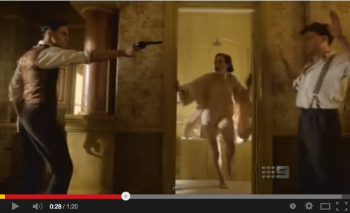
The finale of the show involves a gun fight between Kate and Tilly that ends with them putting down their weapons in a surprising moment of sisterly solidarity. They decide that they do not want to die because the men who will take over their businesses would just “stuff it up.” This end to the feud that has been the driving force of the series is something that would be unlikely to happen had the protagonists been male. Had they been male they would have shot each other and both died tragically in this situation.
These instances of gangster women being represented in recent popular television mark an expansion in the genre. The classic film gangster, Ma Barker notwithstanding, has always been male and the role of gangster has been specifically tied to concerns about masculinity. These gangster women implicitly criticize the inherent masculinity of the gangster figure, both in the ways that they are similar to the male gangster and in the ways that they differ. All these women are competent heads of criminal organizations, successful in their jobs. Only one follows the tradition of the male gangster and dies for her sins. The others pretty much get away with it.
Image Credits:
1. Danielle Cormack portrays Kate Leigh in Underbelly: Razor
2. Margo Martindale as Mags Bennett, an antagonist on Justified
3. Mary-Louise Parker plays Nancy Botwin, a suburban mom turned pot dealer
4. The cast of Weeds
Please feel free to comment.
- Flow asks for articles that are think pieces. This column is about work that I am still in the process of developing. It is underdeveloped but still fascinating. If anyone reading this could mention to me an female gang bosses on television that I have missed I would be most grateful. [↩]
- Female gangsters also occur in prison set shows such as Orange is the New Black, Wentworth Prison, and the British series Bad Girls, but because these are prison shows they belong to that genre not to the genre of gangster. Felicia “Snoop” Pearson and Brianna Barksdale from The Wire, while clearly gangsters, are not in charge of their own organizations. [↩]
- Grieveson, L., E. Sonnet, et al. 2005. ‘Introduction’, in L. Grieveson, E. Sonnet and P. Stanfield (ed) Mob Culture. 1-10. Oxford: Berg. [↩]
- Strunk, M. E. 2005. ‘Mother Barker: Film Star and Public Enemy No. 1’, in L. Grieveson, E. Sonnet and P. Stanfield (ed) Mob Culture. 146-162. Oxford: Berg. [↩]
- i.e. She illegally traded in alcohol. Australia did not have prohibition but alcohol was highly taxed and licensing and sale was strictly controlled, e.g. alcohol could not be served after 6pm. [↩]
- A third major character is a prostitute called Nellie Cameron, and the show also includes a female police officer stated to be the first female officer in New South Wales. [↩]
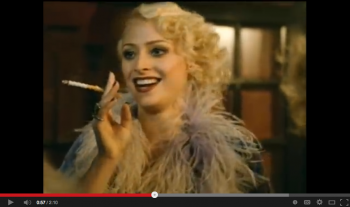
What an interesting subject to look at. Given that you offer the classic definition of the gangster genre as one that revolves around questions of masculinity, do you think these latter-day portrayals of female gangsters are trying to wrestle with definitions of femininity? Or is it just a matter of representation, which in this case happens to appropriate some conventions of a typically masculine genre?
I find it interesting that of these three examples, the only one to have a consistent antihero we’re intended to root for is Weeds, which has a lighter, comedic tone to draw us in to the notion of a female criminal lead. (Assuming that Kate and Tilly are unique in the anthology you discuss – I’m not familiar with that show, but my interest is definitely piqued.)
You may want to take a look at a Dutch program called Penoza, which during its run was remade as an American program called Red Widow (lasting only one season in 2013). The story is about a woman who learns her husband was involved in organized crime, and after his work-related death, she makes her own ascension through the criminal underworld to take his place. (The word “Penoza” was coined by the producer Johan Nijenhuis as a feminization of the Dutch word “penoze,” which roughly translates to “pimps.”) I’m wondering if perhaps one of the reasons it didn’t last long in the United States is because it was broadcast on ABC, which likely has a less “edgy” audience than something like Showtime. Maybe “mainstream” audiences still aren’t ready for a central protagonist who is a female crime boss!
Thank you for your comment Chelsea. And thank you for the recommendation of Penoza and Red Widow. I will track these shows down.
It is possible that the edginess of Showtime does contribute to the success of shows such as Weeds. Underbelly, though it is on broadcast TV is Australia is usually considered to a be a bit edgy. To an extent I think the female gangster is a character whose time has come. I suspect we will see more and more women in these sort of roles. It is surprising to me that there have not been more already. Real life has a large number of examples of female crime bosses and the gangster genre likes to claim a real life status. However, because the genre has been dominated by tales of certain forms of American gangsterism which tend to exclude women, then the stories of female gangsters do not get told.
I do think that these shows are trying to say something about femininity. But there are not enough of them yet to draw strong conclusions about what exactly they are saying about the subject. There is certainly a theme of motherhood and one of sexuality. Also these women while often surrounded by men rarely have a husband. It is only in the absence of such a figure (and Penoza and Red Widow look like they continue this trend) that these women run there own organisations. Femininity of appearance is also something that would be worth examining.
Anyway these are preliminary thoughts but I think very interesting ones. Thank you again for your comment and recommendation.
I enjoyed this article and it made me realize how much women in this genre have changed. I found the inclusion of the Australian show, Underbelly: Razor very interesting. The representations of these characters added a global perspective to the evolution of women in the gangster genre. Women “bosses” in crime television series have become more prevalent in recent years. In Latin America, there has been a trend of soap operas that are centered on women as the head of drug cartels. La Reina del Sur was extremely popular in the United States as is Camelia la Tejana. The women in these programs are breaking gender and cultural norms by being the head of these masculine organizations. However, much like Weeds, they can be over sexualized.
The quiet and docile women of The Godfather era morphed into the assertive women of The Sopranos, and into the mob bosses that are discussed in this article. I think it would be interesting to examine the socio-historical context of these representations and their evolution in relation post feminist on television. How have global perceptions of women allowed them to be in positions of power and keep their sexuality. This was not the case for Justified but I wonder if the power of these women lie in their occupations or sexuality.
Much like the other two commenters, I find this subject matter quite interesting. It is quite fascinating to see the female role in the gangster genre evolve from the woman behind the man to the woman without a man.
I find it intriguing that in the examples provided that the sexualized female bosses are the ones who make it out of their story lines alive, while the “sexless” Ma Barker-esque Mags Bennett follows gangster tropes by going out on her own terms. Is it possible that their feminization is what is concretely separates them from classic masculine gangster tropes and allows them to escape with their lives? As more of these gangster women appear on our television screens, and I am certain they will, it will be interesting to see if there is a clear correlation between being sexualized and avoiding death.
For future reference, I advise you to keep an eye on Fox’s upcoming Batman prequel, Gotham, in which they have cast Jada Pinkett Smith as a female mob boss that will be a creative addition to Batman lore. It will certainly be interesting to see a woman of color enter into this new female boss role that seems to be privy to white women so far. at least from an American television perspective.
I join late this conversation but you may wish to know that there are other recent series revolving around lead characters of gangster women: Mafiosa in France (Canal plus), Antimafia squad in Italy (Canale 5), all of them predated by Bella mafia(ABC)scripted by Kinda La Plante in late nineties. I’m working on the Italian stuff, of course, and find that this peculiar intersection between gender and genre is really worth exploring and thought provoking. I’m also starting to take into consideration the idea to launch a CFP for an edited collection on gangster women in popular culture (be they on top of the organization or not).
Thanks for all these comments.
It is fascinating to me that there are seem to be a reasonable number of these shows from around the world but only one or two in each country. I also think this is something that would greatly benefit from further expansion and would be very interested in an edited collection.